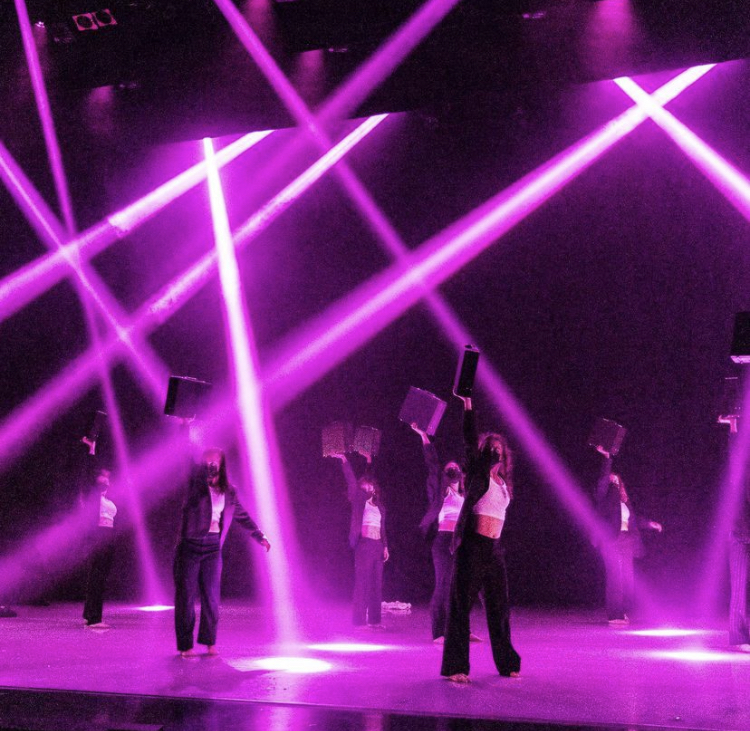Finding the Through-Line of Abstraction in the Department of Dance’s ‘Spring Dance’
March 4, 2022
The Department of Dance at the University of Utah premiered its semi-annual showcase “Spring Dance,” directed by Brent Schnieder, on Feb. 17 . Schnieder presented, in his words, a “mixed repertory” featuring the dance styles of classical ballet, contemporary ballet as well as modern and contemporary dance with influences of hip-hop.
While this combination of vastly differing dance genres may seem jarring, the night felt strangely profound in the variety and dedication to the art the choreography and the dancers exhibited. All at once, it elicited a homogenized and specific emotional reaction out of me and the audience.
On Point Pointe Work
The ballet of the night was represented by two contemporary ballet pieces and one classical piece. The one that stood out to me most, “In the time of…,” choreographed by Cherylyn Lavagnino with assistance by Corinne Hart was a beautiful testament to the lengths to which a ballet piece can embody the nuances of abstraction while still finding the core of emotion and the reason to dance.
The lighting design was brilliant in the hands of Cole Adams, beautifully shaping the dancers’ lines and dramatically darkening the expressions. The piece began with a single pillar of light emanating from an off-stage source prompting a motif in the choreography presented as an outstretched arm and a pivoting 4th position, giving the subtle theme of freedom or escape.
The pointe work was truly stunning with much of the movement being through a pas de bourrée couru or a walking/running step, making the ballet feel obtainable and relatable in a way. The costume design by Christopher Larson did leave me a bit baffled. The dancers wore a flexible jean material on the bottom and flowy lyrical tops that only seemed to distract from the beautiful movements of the dancers, and in my opinion jeans and ballet just don’t mix.
The classical ballet piece “Aimez-Vous Bach?” choreographed by Kevin Thomas offered a jovial, and fittingly classical shift from the contemporary attitude of the night. Offering allegro movements accompanied by cleverly choreographed pas de deuxs and pas de trios.
A Modern Turn
Two contemporary numbers were also presented, the first being “Break” choreographed by LAJAMARTIN along with the dancers themselves. This number was truly a delight delving into the many themes and motifs that could be interpreted in a hundred different ways.
The incredible use of light designed again by Adams was a highlight of the number. Adams used a pale grey to create a noirish tone in the beginning only to meld into sharply focused neon reds and saturated blues as the choreography progressed into a techno hip-hop infusion.
The dancers employed the use of suit jackets, hats, fake cigarettes, and briefcases that were lit from within and a vintage telephone to tell the abstract story that shifted between dancing to instrumental music, sung lyric and spoken word. The spoken word and lip-syncing from the dancers were especially enjoyable, even eliciting laughter from the audience.
It’s certain that the whole range of human emotion was displayed in this riveting number. The final number of the show entitled “The Family” choreographed by Sara Pickett in collaboration with the dancers was a touching finale to the works that had been displayed, again presenting a wide range of emotion and choreographic articulation that kept me at the edge of my seat. “The Family” also made use of two female-presenting dancers in a pas de deux which is always very exciting to see.
Dancers Displaying Artistic Dedication
So what does it all mean? Individually these dances had nothing in common and undulated back and forth in tone and style. Even the numbers on their own can be viewed as an epileptic assortment of choreography, props and music. However, the important thing to notice while viewing the more abstract works of art isn’t so much what exactly they are trying to say, but rather what they are making you feel. The dancers’ dedication to their movement and their storytelling helped me find what I found beautiful, intriguing and heartfelt in every number I witnessed.
Finding the through-line of emotion and passion is the key in viewing art that doesn’t explicitly tell you what to think about what you are watching. And in my opinion that is the beauty of dance. It gets right down to our primal human core and nature: emotion. Dance is the one universal language that is shared by people all across the world. Presenting works with ambiguous meanings but large emotions and passionate dancers can lead to such a variety of reactions and interpretations that goes beyond even what the choreographer’s intent might have been. And isn’t that what art is all about? Experiencing and interpreting it for your own understanding and enjoyment?
“Spring Dance” is open until Feb. 26 with the virtual performance available now at the School of Dance website. Don’t miss the opportunity to experience the beauty of the dancers and the power of abstraction. And be sure to look forward to upcoming performances of “Bizet,” playing April 1 and 2 and “Modern Senior Concert 1 and 2” in March and April.








